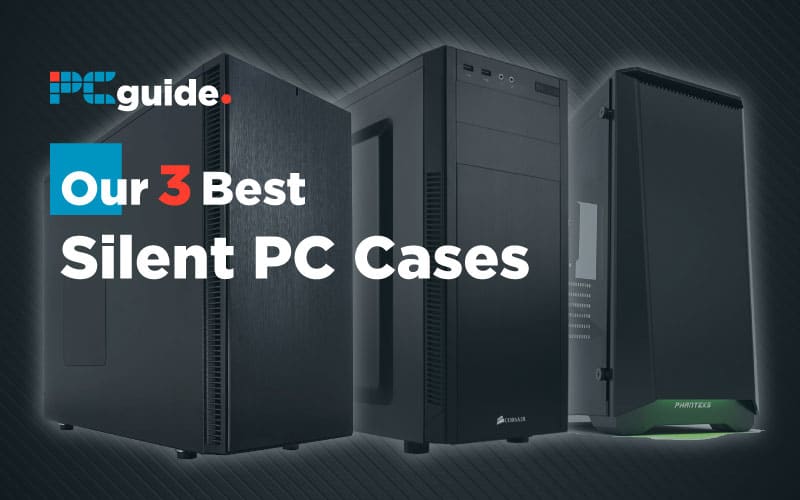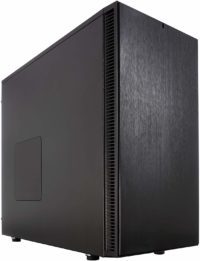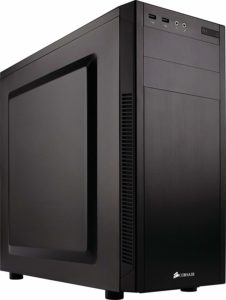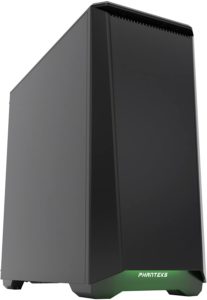Products at a Glance
Product Reviews
- Removable HDD cage
- 8 x 3.5-inch slots
- Case designed with cable management in mind
- Sound-dampened steel panels
- 5.25-inch slots are not removable
Fractal Design is one of the biggest case manufacturers in the PC market. Their Define R5 model is an all-around great, modular case for any build. It’s highly customizable, supports 140 mm fans, has a bottom-mounted power supply, and offers good cable management options to optimize your airflow and case pressure.
If you’re looking for a silent case to build your next system, then look no further. With 140mm fan support both on the front panel and at the top, you can supply your case with optimal airflow, keeping your components nice and cool for both idling and resource-intensive tasks. The top of the case can also house a 420mm radiator, perfect if you’re considering liquid cooling as a solution for your CPU.
The removable drive cage helps improve airflow if you’re planning on mounting additional front-panel fans, and also helps with cable management. The case actually comes with embedded cable management solutions, like velcro straps and grommets to keep your cables tight and snug, well-thought-out cutouts to mask your bigger wires, and an opaque right-side panel to mask it all.
The sound-dampened steel panels help keep your build nice and quiet, and the support for radiators and 140mm fans gives you the option to add more potent cooling. Overall, it’s a good balance of features and soundproofing options.
- Silent Edition comes with sound-proofing panels
- Extra intake fan
- Underwhelming cable management options
- No top clearance for extra fans
Both the 100R and Silent Edition seem like pretty solid choices for any build. For a silent system, we’ll be focusing on the later version, since it’s better suited for such use. It does have pros and cons, like every case, so let’s go through these now.
Right off the bat, there’s no top panel support for your radiator. This has been replaced by a soundproofing panel, giving you a good, linear front-back airflow. If you’re not planning on running very power-heavy applications, cooling should be more than adequate.
Both the side panels feature the same treatment, a good soundproofing design for any build. The front panel can accommodate two 120/140mm fans, enough to blow the hot air from your CPU and GPU into the exhaust. The Corsair Carbide 100R Silent Edition already comes with front and exhaust fans, giving you almost optimal airflow straight out of the box.
While cable management options are not great, it’s not a big problem, since this model doesn’t feature a glass panel. The existing options are good enough to provide unrestricted airflow.
- Very sleek look
- The illuminated front panel included
- 4 sound-proofed panels (front, top, and sides)
- Rear panel only supports 120mm exhaust fan
The Phanteks Eclipse P400S is a great-looking case with plenty of features for beginners and enthusiasts alike. Coming in three color variants (black, grey, and white), it can fit right in with your existing peripherals, a big plus when compared to the two previous mentions.
This case also supports two 140mm fans on the top panel, which can be masked using magnetic plastic covers if you decide against it. The front panel LEDs are compatible with ASUS Aura Sync, MSI Mystic Light, and GIGABYTE’s RGB Ready drivers provided your motherboard has a compatible connector. The panels are sound-damping, creating an optimal acoustic environment for your build.
The interior is great for any build, very spacious, with a lot of grommets and velcro straps for cable management. The PSU cage doesn’t feature any cutouts, so make sure you route your cables accordingly, especially with such a good-looking case.
The front, top, and side panels are designed with soundproof coating, the steel panels having a glossy finish. If you remove the HDD cage from the front panel, you can mount a 360mm AIO cooler, giving you options for overclocking without having to suffer any extra penalties in the noise department.
Things to consider
Pick A PSU From A Reputable Manufacturer
The power supply unit can also cause a lot of noise. This is why you should pick something that’s at least 80+ Bronze certified, with a fan that can handle all of the heat. The smaller the fan, the more noise it makes.
Pick Adequate Cooling Options
If you’re planning on installing a top-tier CPU and GPU in your system, then you should know that these components are typically power-hungry and require proper cooling to function correctly and silently. For CPUs, you can consider picking a robust air cooler, or you can mount a radiator to water-cool your processor. This will give you better overclocking capabilities, more stable temperatures, and overall better performance.
For your GPU, you should really make sure that your top-mounted fans aren’t blowing hot air from the CPU into your GPU. Moreover, if you’re using a vertical-mounting bracket, give the fans enough space to draw in air.
How Do I Set A Custom Fan Curve
A custom fan curve is the best thing you can do to keep your fans from spinning out of control. By using software such as MSI Afterburner, you can control how fast your fans are spinning at different temperatures. It’s straightforward and intuitive to use, and you can control your fans individually if your motherboard supports this.
Our Verdict
Because of its very sleek aesthetic, modularity, simplicity, and a hefty list of features, we think that the Phanteks Eclipse P400S is the best choice for a silent PC build. Its soundproofed panels are high-quality steel, the case is spacious and easy to work with, and the front LEDs have support for RGB-syncing software, which is always a plus if you want to build an elaborate, visually-impressive setup. You can fit an AIO cooler, and the tempered glass side panel is sure to give you an incentive to put some effort into cable management and get a good, clean, and airflow-optimized build.




